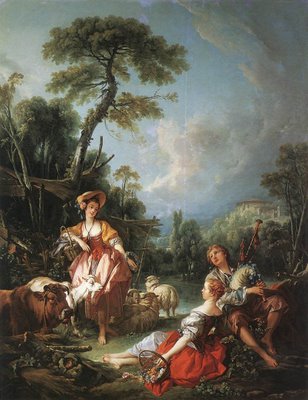 It was all a lie, of course. The movement, like its patrons, met its end at the guillotine and the Edenic existence it portrayed was built upon the backs of the destitute French peasantry.
It was all a lie, of course. The movement, like its patrons, met its end at the guillotine and the Edenic existence it portrayed was built upon the backs of the destitute French peasantry.Still - let us indulge in their illusion for a while and take a walk through the Garden that the French aristocracy reveled in. French (to differentiate from the Italian variant) Rococo reached its apex during the tenure of court painter Francois Boucher (1703-1770).
I once saw a special exhibit of Boucher's work at the Kimbell. They are massive, wall-devouring canvases. A Summer Pastoral (1749, at the Wallace) is 8 1/2 by 6 1/2 feet wide. Here the aristocracy disastrously misrepresents the lifestyle of the lower classes, but let's ignore the socioeconomic analysis of the painting for the time being. Let the dead bury the dead.
Here we see happy people and happy farm animals. And happy little trees. All relishing an idle afternoon of picking flowers and playing bagpipes. No one is knocking on the parsonage door, asking to be let into the church. No one is critiquing your sermon. And there are no District Superintendents in sight. Art is therapeutic, folks. Indulge in happy art.
 Adoration of the Shepherds (1750 at the Musee des Beaux-Arts in Lyon). Notice how in this painting and in the previous one, Boucher frames the top of the painting in a circular sweep of clouds. He did this a lot. It creates a sense of separateness or sanctuary. Boucher's work is many things, but it is fundamentally escapist. After a stressful day of flogging peasants and chasing chambermaids, a man needed to rest and relax. A Boucher painting provided him with a private, joyful world that was sheltered from the woes of everyday life.
Adoration of the Shepherds (1750 at the Musee des Beaux-Arts in Lyon). Notice how in this painting and in the previous one, Boucher frames the top of the painting in a circular sweep of clouds. He did this a lot. It creates a sense of separateness or sanctuary. Boucher's work is many things, but it is fundamentally escapist. After a stressful day of flogging peasants and chasing chambermaids, a man needed to rest and relax. A Boucher painting provided him with a private, joyful world that was sheltered from the woes of everyday life.Whether you're a pastor or an engineer or a peasant-flogger, you need a place of escape, too. Load up a Boucher pic as your screensaver and slip away.
 The circular effect is even more pronounced in Vulcan Presenting Venus with Arms for Aeneas (1757, at the Louvre). Happy gods, happy cherubs, and happy little clouds.
The circular effect is even more pronounced in Vulcan Presenting Venus with Arms for Aeneas (1757, at the Louvre). Happy gods, happy cherubs, and happy little clouds.Some painters make you think. Some make you cry. Some make you a pretentious chain-smoking art snob consciously putting angst into every facial expression.
But Boucher? He makes you relax. Relaxation is good. So slip away into his world.

No comments:
Post a Comment